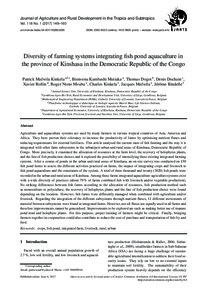| dc.date.accessioned | 2017-06-08T07:25:43Z | |
| dc.date.available | 2017-06-08T07:25:43Z | |
| dc.date.issued | 2017-06-06 | |
| dc.identifier.issn | 1612-9830 | |
| dc.identifier.issn | 2363-6033 | |
| dc.identifier.uri | urn:nbn:de:hebis:34-2017032852295 | |
| dc.identifier.uri | http://hdl.handle.net/123456789/2017032852295 | |
| dc.language.iso | eng | |
| dc.publisher | Kassel University Press | ger |
| dc.rights | Urheberrechtlich geschützt | |
| dc.rights.uri | https://rightsstatements.org/page/InC/1.0/ | |
| dc.subject | crops | eng |
| dc.subject | fish pond | eng |
| dc.subject | integrated farm | eng |
| dc.subject | livestock | eng |
| dc.subject | rural | eng |
| dc.subject | urban | eng |
| dc.subject.ddc | 630 | |
| dc.title | Diversity of farming systems integrating fish pond aquaculture in the province of Kinshasa in the Democratic Republic of the Congo | eng |
| dc.type | Aufsatz | |
| dcterms.abstract | Agriculture and aquaculture systems are used by many farmers in various tropical countries of Asia, America and Africa. They have proven their relevancy to increase the productivity of farms by optimising nutrient fluxes and reducing requirements for external fertilisers. This article analysed the current state of fish farming and the way it is integrated with other farm subsystems in the urban/peri-urban and rural areas of Kinshasa, Democratic Republic of Congo. More precisely, it examined the allocation of resources at the farm level, the recovery of helophytes plants, and the fate of fish production choices and it explored the possibility of intensifying these existing integrated farming systems. After a census of ponds in the urban and rural areas of Kinshasa, an on-site survey was conducted on 150 fish pond farms to assess the different activities practiced on farms, the impact of integrating crops and livestock to fish pond aquaculture and the constraints of the system. A total of three thousand and twenty (3020) fish ponds were recorded in the urban and rural areas of Kinshasa. Among these farms integrated aquaculture-agriculture systems exist with a wide diversity of practices (about 79% of farms combined fish with livestock and/or vegetable production). No striking differences between fish farms according to the allocation of resources, fish production method such as monoculture or polyculture, the recovery of helophytes plants and the fate of fish production choice were found depending on the location. However, fish farms were differently managed when combined with agriculture and/or livestock. Regarding the integration of the different subsystems through nutrient fluxes, 11 different movements of material between subsystems were found in integrated farms. However, not all fluxes are equally used in all farms and therefore improvements cannot be generalised. Improvements to be explored are such as making better use of manure pond mud and helophyte plants. For this purpose, proper training of farmers might be critical. Finally, bringing farmers together in cooperatives could also contribute to reduce the cost of purchase and transportation of fish fry and feed. | eng |
| dcterms.accessRights | open access | |
| dcterms.bibliographicCitation | In: Journal of Agriculture and Rural Development in the Tropics and Subtropics. Kassel : Kassel University Press. - Vol. 118, No. 1 (2017) S. 149-160 | |
| dcterms.creator | Kinkela, Patrick Mafwila | |
| dcterms.creator | Mutiaka, Bienvenu Kambashi | |
| dcterms.creator | Dogot, Thomas | |
| dcterms.creator | Dochain, Denis | |
| dcterms.creator | Rollin, Xavier | |
| dcterms.creator | Mvubu, Roger Ntoto | |
| dcterms.creator | Kinkela, Charles | |
| dcterms.creator | Mafwila, Jacques | |
| dcterms.creator | Bindelle, Jérôme | |
| dc.description.everything | Gedruckte Ausg. im Verlag Kassel Univ. Press (www.upress.uni-kassel.de) erschienen. | ger |

